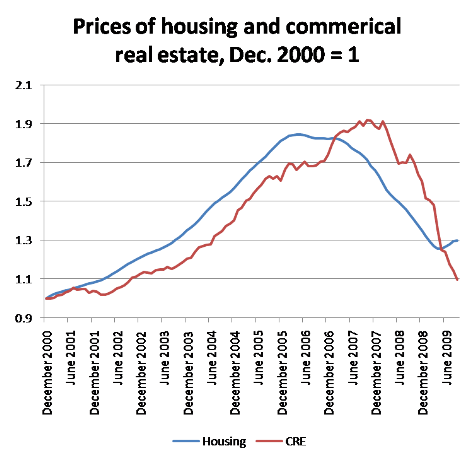With the intentions of preventing foreclosures and strengthening the financial system, the FDIC and the U.S. Treasury have created guidelines for modifying mortgages, and require that the guidelines be followed for a large class of mortgages. The guidelines include an income share target (for housing expenditures), a NPV test, and voluntary participation by borrowers. This paper shows how the facts that actual modifications do little to reduce principal, are still outnumbered by foreclosures, and add to borrower uncertainty, may directly result from incentives created by those very guidelines.
Through their income share target and “NPV test,” the federal modification programs have manufactured a tradeoff between the number of foreclosures prevented in the short term and the durability of those foreclosure prevention efforts, because they make it impossible to both write down principal and offer modification to a wide range of borrowers. Another result of this tradeoff is to reduce collections, increase foreclosures and their costs, and reduce efficiency as compared to alternative means-tested mortgage modification rules.
In many instances the programs create implicit marginal income tax rates in excess of 100 percent, and sometimes as large as 400 percent. One might expect a lot of income to be destroyed (or at least detoured off personal income tax returns where lenders might see them) in an economy where millions of people faced such massive marginal income tax rates, but, for two reasons, this paper does not investigate this possibility. First, reasonable people can debate the degree to which the supply of income responds to marginal tax rates, but resolving this debate is unnecessary for proving any of the results of this paper. Even if the supply of income were fully exogenous – that is, failed to respond even a small amount to marginal tax rates in excess of 100 percent – several of my results still hold. Second, under the weak assumption that borrowers cannot be expected to perennially locate at points of their budget sets that are strictly dominated by tens of thousands of dollars, lenders who want to enhance collections will take steps to foreclose on borrowers who are deemed modification-eligible by the federal programs. These steps will dull (but probably not eliminate) the otherwise stark incentives for borrowers to reduce their incomes in order to be eligible for a generous modification, and thereby result in an income distribution impact of the programs that is less than it would be had the guidelines been followed literally.
The fact that foreclosures continue to outnumber modifications almost two years after federal initiatives began has been blamed on complex legal relationships among mortgage owners, and on administrative snafus. These factors may contribute to the relatively slow pace of modification, but, even without them, the federal income share target automatically frustrates the programs’ foreclosure prevention goals, thanks to the strong economic incentives it presents to borrowers and lenders. The same economic analysis explains why the federal guidelines discourage principal reductions (in favor of interest deductions) because principal reductions are consistent with only a narrow eligibility range, and implicitly impose marginal tax rates as large as 400 percent, despite the possibility that principal reductions would be a more durable foreclosure solution.
[excerpt from a paper coming out in two weeks]
Through their income share target and “NPV test,” the federal modification programs have manufactured a tradeoff between the number of foreclosures prevented in the short term and the durability of those foreclosure prevention efforts, because they make it impossible to both write down principal and offer modification to a wide range of borrowers. Another result of this tradeoff is to reduce collections, increase foreclosures and their costs, and reduce efficiency as compared to alternative means-tested mortgage modification rules.
In many instances the programs create implicit marginal income tax rates in excess of 100 percent, and sometimes as large as 400 percent. One might expect a lot of income to be destroyed (or at least detoured off personal income tax returns where lenders might see them) in an economy where millions of people faced such massive marginal income tax rates, but, for two reasons, this paper does not investigate this possibility. First, reasonable people can debate the degree to which the supply of income responds to marginal tax rates, but resolving this debate is unnecessary for proving any of the results of this paper. Even if the supply of income were fully exogenous – that is, failed to respond even a small amount to marginal tax rates in excess of 100 percent – several of my results still hold. Second, under the weak assumption that borrowers cannot be expected to perennially locate at points of their budget sets that are strictly dominated by tens of thousands of dollars, lenders who want to enhance collections will take steps to foreclose on borrowers who are deemed modification-eligible by the federal programs. These steps will dull (but probably not eliminate) the otherwise stark incentives for borrowers to reduce their incomes in order to be eligible for a generous modification, and thereby result in an income distribution impact of the programs that is less than it would be had the guidelines been followed literally.
The fact that foreclosures continue to outnumber modifications almost two years after federal initiatives began has been blamed on complex legal relationships among mortgage owners, and on administrative snafus. These factors may contribute to the relatively slow pace of modification, but, even without them, the federal income share target automatically frustrates the programs’ foreclosure prevention goals, thanks to the strong economic incentives it presents to borrowers and lenders. The same economic analysis explains why the federal guidelines discourage principal reductions (in favor of interest deductions) because principal reductions are consistent with only a narrow eligibility range, and implicitly impose marginal tax rates as large as 400 percent, despite the possibility that principal reductions would be a more durable foreclosure solution.
[excerpt from a paper coming out in two weeks]












